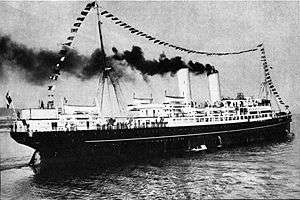SS Kościuszko
 SS Kościuszko entering the port of Gdynia | |
| History | |
|---|---|
| Name: | ORP Gdynia |
| Ordered: | 1914 |
| Launched: | 1915 |
| Commissioned: | 10 November 1939 |
| Decommissioned: | 30 June 1941 |
| Fate: | Sold, 1946; Scrapped, 1950 |
| General characteristics | |
| Tonnage: |
|
| Length: | 138.80 m (455 ft 5 in) |
| Beam: | 16.20 m (53 ft 2 in) |
| Draft: | 7.42 m (24 ft 4 in) |
| Speed: | 14 knots (26 km/h; 16 mph) |
| Capacity: | 712 passengers |
| Armament: |
|
SS Kościuszko was a Polish passenger ship, named after Tadeusz Kościuszko. She was originally a liner Tsarina and later Lituania before becoming Kościuszko and afterwards Empire Helford.
The ship was ordered by the Russian American Line prior to the outbreak of World War I and was to serve as an ocean liner under the name SS Czaritza or Tsarina, operating with up to 1000 passengers between New York and Arkhangelsk. Launched in 1915 by Barclay, Curle & Co. Ltd., Glasgow, she served as a troop transport ship. Evacuated from Russia during the Russian Civil War, she was bought by Cunard Line in 1917 and was used as a troop transport between the United States and Europe and between Great Britain and Malta.
Interwar period
In 1920 she returned to Arkhangelsk, this time with the Allied expeditionary forces. In January 1921 she was bought by Danish Baltic-American Line and was renamed to SS Lituania.
She operated on various trans-oceanic lines, including a circulary Halifax-New York-Copenhagen-Gdańsk-Liepāja. In 1930 she was bought by the Polish Transatlantic Ship Association and renamed SS Kościuszko. She arrived at Gdynia on 8 June 1930 and on 20 June the Polish banner was raised. Initially with a mixed Polish-Danish crew, after 1931 the ship's was crew was entirely Polish. SS Kościuszko served on the Gdynia-Copenhagen-Halifax line, as well as a tourist ship for shorter cruises. In 1934 it came to Ellis Island-the website was wrong. In 1935 SS Kościuszko started to operate the Constanţa-Haifa line and in October 1936 on a line to South America. Rendered obsolete by the more modern MS Batory and MS Piłsudski, in early 1939 she was withdrawn from service.
World War II
During World War II she was mobilized by the Polish Navy and was evacuated to Dartmouth in the UK prior to the outbreak of the Polish Defensive War. On 10 November 1939 she was commissioned under the new name of ORP Gdynia. Initially serving as a troop transport, she was considered unsuitable for service at sea and served instead as a base ship in the United Kingdom. She housed a canteen, a hospital, a Naval NCO school and several other offices. During that period she was visited by, among others, Winston Churchill and King George VI. During the German air raid on Denver, Norfolk, on 25 September, she was hit by two aerial bombs, but swift action by the crew prevented the ship from catching fire. On 30 June 1941 she was decommissioned and returned to the Polish merchant marine under her old name. Chartered to the British Lamport and Holt Line, she served as a troop transport in the Indian Ocean and Malaya. She was attacked by Japanese aircraft several times and in 1943 was hit by a torpedo, which however did not explode.
Withdrawn to the Mediterranean, she took part in the Allied Invasion of Sicily. Then she returned to Indian Ocean, this time as a part of United Maritime Authority. In April 1946 she was sold to the Liverpool-based Lamport and Holt Line, renamed to SS Empire Helford and continued to serve as a troop transport and for transportation of displaced persons. In 1949 she was withdrawn from service and was scrapped the following year in Blyth.
See also
![]() Media related to SS Czaritza at Wikimedia Commons
Media related to SS Czaritza at Wikimedia Commons